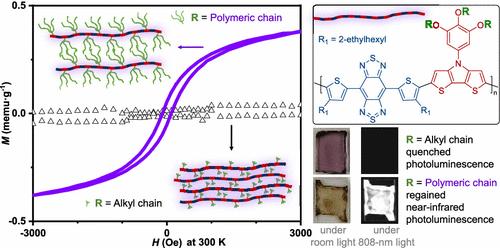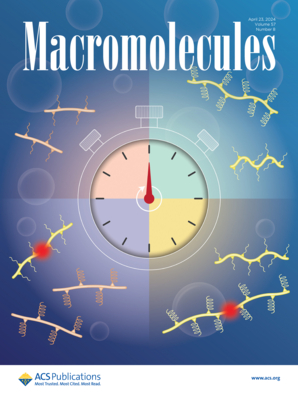Room-Temperature Ferromagnetism and Near-Infrared Luminescence Enabled by Interchain-Aggregation Control of Open-Shell Donor–Acceptor Alternating Copolymers
IF 5.1
1区 化学
Q1 POLYMER SCIENCE
引用次数: 0
Abstract
Charge transfer in alternating donor–acceptor (D–A) conjugated polymers plays a crucial role in the development of organic electronics and spintronics. However, the contribution of intrachain charge transfer to the optoelectronic properties remains poorly understood due to the interference of interchain aggregation. Here, we report an approach to rational control of the interchain interaction of an open-shell D–A polymer through segregation of strongly interactive backbones, from which polymeric side chains are grafted so that the intrachain interaction between donors and acceptors becomes dominant. The grafted bottlebrush polymers are still open-shell, owing to the presence of unpaired conduction electrons along the π-conjugated backbones, resulting in asymmetric electron spin resonance. Meanwhile, the minimized interchain aggregation leads to near-infrared photoluminescence despite the narrow optical band gap. Surprisingly, the intrachain dominating D–A charge transfer and delocalization, together with the long-range structural ordering of these bottlebrush polymers in solid states, enables ferromagnetism both at and below room temperature. The effects of the chain length and the grafting density of the polymeric side chains on the optical and magnetic properties have been studied in detail.

求助全文
约1分钟内获得全文
求助全文
来源期刊

Macromolecules
工程技术-高分子科学
CiteScore
9.30
自引率
16.40%
发文量
942
审稿时长
2 months
期刊介绍:
Macromolecules publishes original, fundamental, and impactful research on all aspects of polymer science. Topics of interest include synthesis (e.g., controlled polymerizations, polymerization catalysis, post polymerization modification, new monomer structures and polymer architectures, and polymerization mechanisms/kinetics analysis); phase behavior, thermodynamics, dynamic, and ordering/disordering phenomena (e.g., self-assembly, gelation, crystallization, solution/melt/solid-state characteristics); structure and properties (e.g., mechanical and rheological properties, surface/interfacial characteristics, electronic and transport properties); new state of the art characterization (e.g., spectroscopy, scattering, microscopy, rheology), simulation (e.g., Monte Carlo, molecular dynamics, multi-scale/coarse-grained modeling), and theoretical methods. Renewable/sustainable polymers, polymer networks, responsive polymers, electro-, magneto- and opto-active macromolecules, inorganic polymers, charge-transporting polymers (ion-containing, semiconducting, and conducting), nanostructured polymers, and polymer composites are also of interest. Typical papers published in Macromolecules showcase important and innovative concepts, experimental methods/observations, and theoretical/computational approaches that demonstrate a fundamental advance in the understanding of polymers.
 求助内容:
求助内容: 应助结果提醒方式:
应助结果提醒方式:


